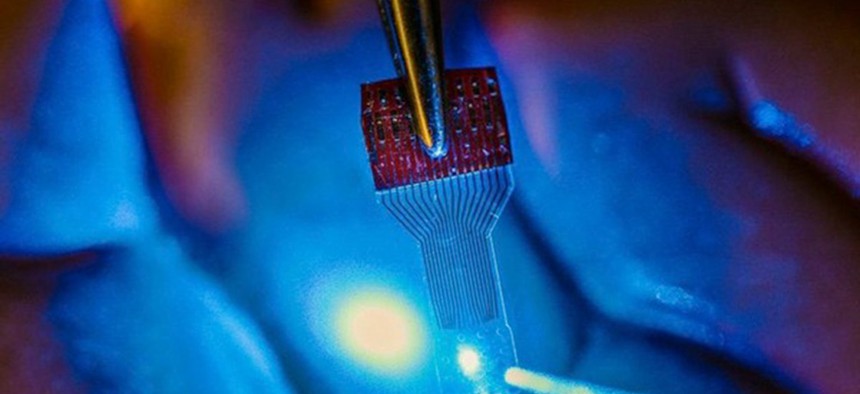
A picture of the graphene-based brain chip used in this experiment. Justin Williams research group
Here’s What the Next Brain Implant Will Be Made Of
Ever heard of graphene? A recent DARPA-funded study suggests it could soon be in brain implants. By Patrick Tucker
Researchers from the University of Wisconsin, with funding from the Defense Advanced Research Projects Agency, DARPA, have created a new type of brain chip made of graphene that could bring futuristic brain implants much closer to reality.
If you haven’t heard of graphene, you aren’t alone. In 2010, Andre Geim and Konstantin Novoselov received the Nobel Prize in physics for creating it in the usable form we recognize it in today. But in its purest form, it’s been around for billions of years. It’s basically carbon, one atom thick and stuck together in honeycomb shaped bonds, then stacked. Though extremely simple, it’s also miraculous. It’s the most electrically conductive material known to man. A recent DARPA grant allocated just under $30 million to build next generation transistors from graphene. Money from the private sector has been pouring into the development of graphene batteries as a potential replacement for lithium ion.
Some military-related applications for brain chips include treating PTSD flashbacks or episodes the moment that they occur. Neural activity can clearly—and silently—communicate stress as well as other emotional states. It can speak to how well an individual or a soldier is learning material before that soldier sits down to take a test, thanks to some cutting-edge research performed at Sandia National Labs in 2012. It could even lead the way to much more responsive even “feeling” robotic prosthetic arms and legs. A properly devised brain interface could relay signals as communication, or accomplish other tasks you might read about in a comic book.
University of Wisconsin
Here’s why graphene may also make its way into tomorrow’s brain chips.
Today, our crude efforts to study brain signals via surgically implanted devices are limited to chips composed of indium-tin oxide, ITO, platinum, and other metallic materials. But even at their thinnest, these devices aren’t transparent, which is a limiting factor if you want to do experiments on the brain that involve not just electrical signals but light, an emerging area of brain research called optogenetics. Optogenetics is quickly becoming one of the most important (and least invasive) avenues for brain research. The real problem with today’s brain chips is that brains and hot metal just don’t mix well.
(Read More: The Military Is Building Brain Chips To Treat PTSD)
“We've just begun to look at the biocompatibility of these devices in the brain, but have so far been able to implant them for months into the brains of living animals with no obvious adverse effects,” University of Wisconsin researcher Justin Williams, one of the authors of the study, told Defense One. “Graphene also has some other potential advantages, as it has been shown that it can be doped to be used as a semiconductor, which means we can start to use it to make implantable active electronic circuits as well.”
So graphene is both thin enough to interact with brains without harming them (as much as does metal) and conducive enough for electricity. That quality of thinness, in addition to its atomic purity, makes graphene compatible with biological material said Williams.
“We have recently published studies that show than the less overall material that you implant into the brain, the more favorable the scarring reaction is,” Williams said. “Think of this as the areal density - that is how much material per unit area of the surface of the brain we need to achieve the device's functionality. With traditional materials we are limited by the material's conductivity and processing capabilities. That is, we can only process metals so thin, and pattern them so small before they lose the functionality that we need. With graphene we should be able to push these limits significantly smaller without losing the necessary conductivity and strength. In the current report we've already reduced the thickness by several orders of magnitude.”
The University of Wisconsin researchers devised a graphene-based device called carbon-layered electrode array or CLEAR, for visualizing and stimulating brain activity. It could lead to a much better understanding of the brain as well as devices that can interact directly with the brain.
Because graphene is atomically pure carbon, it’s not toxic. This means that it’s far more biocompatible than even gold or platinum.
The researchers tested the novel graphene-based brain chips on four rats and five mice to see if the material was sufficiently transparent to allow light to come through (for experiments based on light) but was also capable of delivering a robust enough signal to make the animals’ legs move. And the readings were better than could be achieved with regular metal implants. They published their findings in the journal Nature.
It’s a small feat (controlling small feet), but it suggests that scientists are one important step closer to designing chips and eventually mind-controllable arms, legs and even exoskeletons that are truly brain friendly.




